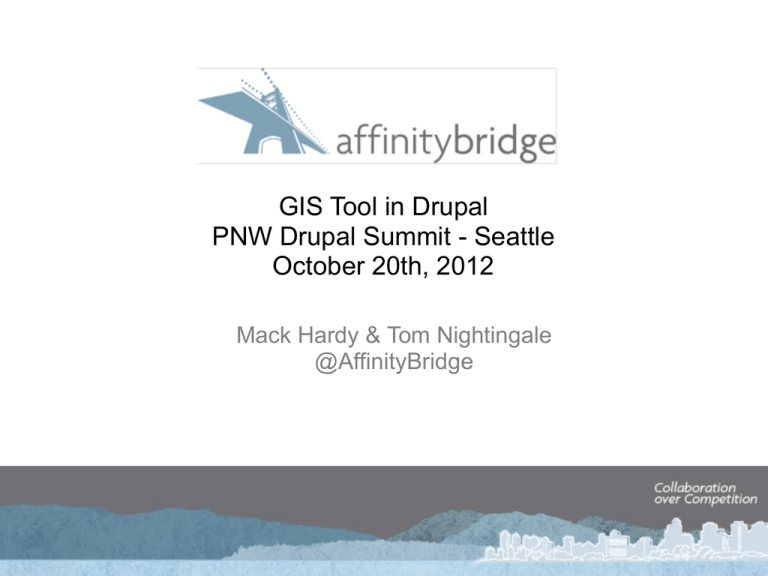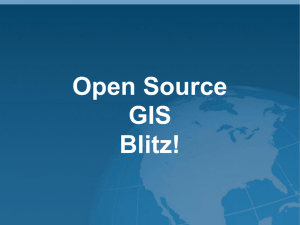Presentation slides for this session
advertisement

GIS Tool in Drupal
PNW Drupal Summit - Seattle
October 20th, 2012
Mack Hardy & Tom Nightingale
@AffinityBridge
History of Maps with Drupal Tools
Location Module,
proximity and filter
Storage and Import
Storage - GeoField
Where do we store data in drupal?
A common field format
for geodata
• WKT
• Lat Lon
• Bounding
Spatial Import
How do we import data from external sources?
Shapefiles
KML files
Uses GeoPHP and ogr2ogr
Spatial module -> Saves as WKT -> Geofield
http://drupal.org/project/spatial
ogr2ogr
Wrapper module for the GDAL ogr2ogr library
- Spatial module calls ogr2ogr
- Converts data from source formats to WKT
http://drupal.org/project/ogr2ogr
Query
Sync_PostGIS Module
• Allows drupal to query PostGIS as a spatial query
service, much in the way SOLR is used for search
• Syncs data from Drupal entities with geofields to
PostGIS
• Provides query methods for testing intersection,
within, buffer conditions
http://drupal.org/project/sync_postgis
Sync_PostGIS Module
What does sync_postgis tell us?
Intersections with other data points
Within a buffer of 5km
Testing for Intersection
function geoquery_intersects($item1, $item2) {
$params = array($item1, $item2);
foreach ($params as &$param) {
if (is_scalar($param)) {
$param = array('entity_type' => 'node', 'eid' => $param);
}
}
if ($connection = sync_postgis_get_postgis_connection()) {
$geo_query = new syncPgQuery($connection);
return $geo_query->booleanRelQuery('intersects',
$params[0], $params[1])->execute();
}
Testing for Buffer Distance
function geoquery_dwithin($item1, $item2, $distance = 0, $srid = 4326)
{
$params = array($item1, $item2);
foreach ($params as &$param) {
if (is_scalar($param)) {
$param = array('entity_type' => 'node', 'eid' => $param);
}
}
if ($connection = sync_postgis_get_postgis_connection()) {
$geo_query = new syncPgQuery($connection, $srid);
return $geo_query->booleanRelQuery('dwithin', $params[0],
$params[1], $distance)->execute();
}
}
Displaying the results
With the results from the PostGIS
backend, we can show the user
useful information
In this case they know that
- target is in the protected area
- target intersects 2 traplines
- target is within a 5 km buffer of 4
other nodes of interest
Scaling
Beyond Vector Based Maps
We want to show huge datasets, the vector model requires
"painting" the data onto the map, which is computationally
expensive
Pre-rendering the dataset onto a tile, means the client can
load the data quickly, and tiles are easy to cache
Obvious downside of caching, is that it doesn't work well
with frequently changing data
Tilemill has been great for creating base tiles, but
regenerating the entire tileset when the data changes is
hard and time consuming
Comparing Vector vs MB Tiles
Vector - 2.30 MB of transfer - Client side render
Tiles - 529 kB of transfer - Server side render
Tilestache
Python application for serving tiles
tilestache takes inputs of :
--- mbtiles which are pre-generated
--- mapnik configuration (to generate tiles on the fly)
--- vector (geojson, arcjson)
--- combinations of these inputs as composite
We are generating using mapnik with PostGIS as a datasource
- provides a caching layer for serving tiles
Composite maps from PostGIS Data
• base map satellite images
• tilestache provides the data layers
from PostGIS via mapnik
• leaflet map definition points to
layers in the layer switcher
Image credit http://mike.teczno.com/notes/tilestache.html
WAX interactivity
• parcel data with tiles in JSON
• on mouseover and on click behaviours
• need to pre-cache WAX styling
WAX interactivity
WAX interactivity
Demo
WAX interactivity
How UTF8 grid works
http://mapbox.com/demo/visiblemap/
Random Tools
Leaflet Draw
Leaflet Paste
Search API
Next we want to be able to return data items from
SOLR to a map
Search on non-geographic facets - just like a view
Search on geographic facets - facet controls pull data
from PostGIS, or use SOLRs spatial extensions
http://drupal.org/project/search_api_location
Discussion
mack@affinitybridge.com
http://affinitybridge.com











